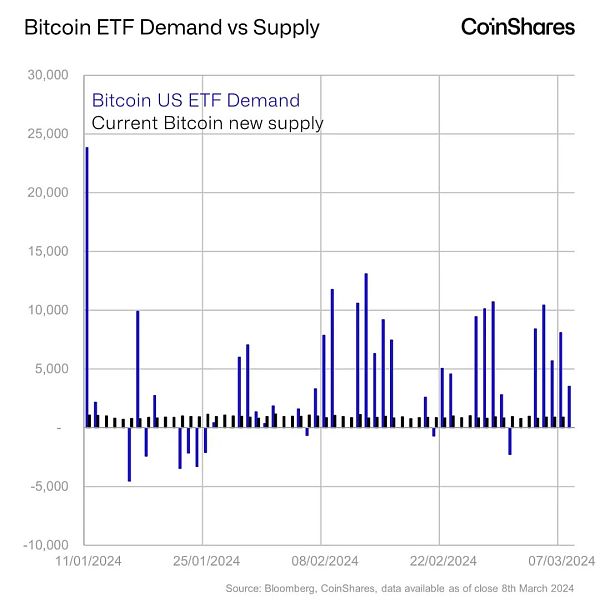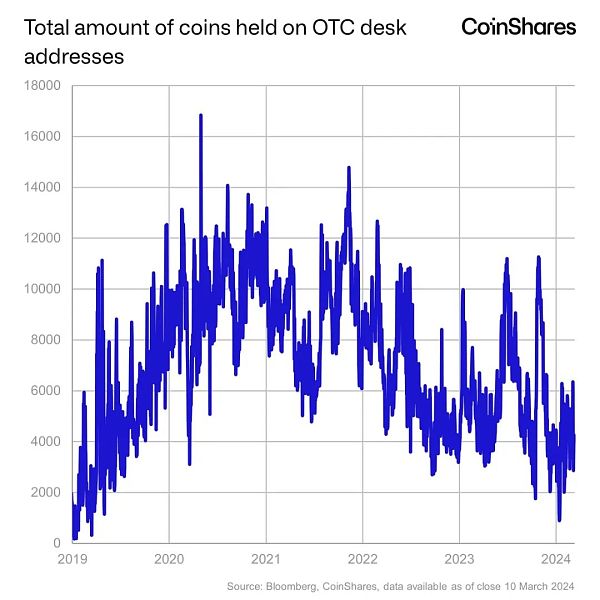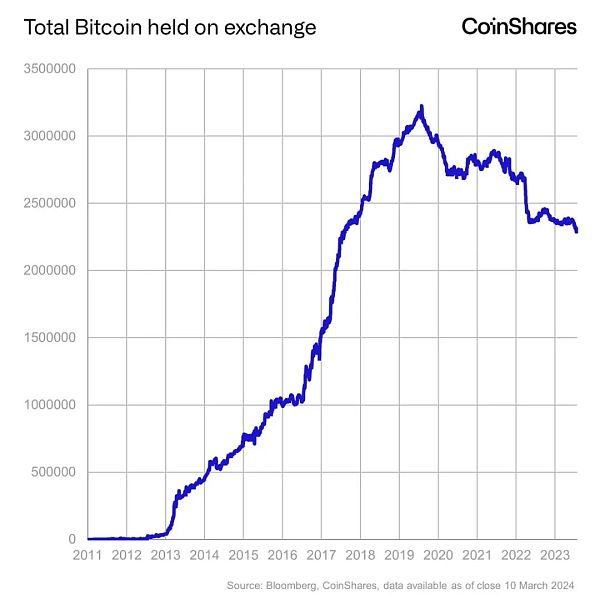Author: James Butterfill
In the commodities world, a demand shock is a sudden and significant change in demand for an essential commodity or raw material caused by an unforeseen event. A positive demand shock results from an increase in demand, perhaps due to technological innovation, policy changes, or a shift in consumer preferences, which drives up prices. In the early 2000s, China's economic boom and accelerated real estate development triggered a commodity demand shock that caused steel prices to rise by 793% between 2000 and 2008. Slowing economic growth after the financial crisis, combined with a massive increase in production as a result of the supply response, caused steel prices to fall by 80% over the next decade.
We believe Bitcoin is currently experiencing a positive demand shock. The U.S. Securities and Exchange Commission’s (SEC) approval of spot-based ETFs, which allows more than $14 trillion in assets to be invested in traditional markets, is well known, but its timing is unclear and the resulting inflows Nor is there broad consensus on scale. So far, the ETF launch on January 11 has resulted in average daily demand of 4,500 Bitcoins (trading days only), while at the same time, average daily mining of new Bitcoins has been just 921.

This has led to the massive rise in Bitcoin prices we've seen in recent weeks, as the supply of newly mined Bitcoin has failed to keep up with demand, resulting in ETF issuers having to source primarily from the secondary market. We can see this in the data, where OTC market holdings have fallen 74% since their peak in 2020, most likely due to ETF demand in recent years.

US ETFs witnessed record inflows of $10 billion in the first two months, compared to iShares' first gold ETF, first launched in 2005, which saw net inflows of just $28.8 million in the first two months Dollar. In the first two months of 2020, just before the halving, the ETP saw $436 million in inflows, accounting for 11% of its total assets under management, very similar to today, with recent inflows at 11%, even in nominal terms In value terms, today's inflows are also 23 times those in 2020.
We have also seen a significant reduction in Bitcoin holdings on exchanges, which have dropped 29% since 2020 as investments Investors are increasingly utilizing ETPs, or custody of Bitcoin themselves, reflecting their increasing view of it as a store of value.

At the current demand rate of about 4,500 Bitcoins per day, it would take 573 days to balance the exchange, so it's clear there's still a long way to go.
After a demand shock occurs in commodity markets, there is usually a supply response. Over time, suppliers adjust their production levels to new demand conditions. In the event of a positive shock to demand, producers may increase production capacity or seek to increase efficiency to meet higher demand. However, Bitcoin differs from commodity markets in that Bitcoin has a fixed and immutable supply mechanism model that is programmed to halve the supply every 210,000 blocks or approximately every 4 years.
Ultimately, the market will seek a new balance at the intersection of supply and demand. This adjustment process can be fast or slow, depending on the magnitude of the shock. Given the inflexibility of Bitcoin supply, a new equilibrium can only be found at the price level. This is why we’ve seen Bitcoin prices rise so sharply in recent months, with demand for ETFs and the upcoming halving exacerbating the problem.
The halving is well-known information and, at least in theory, should have been factored into price expectation models. One could argue that the post-halving price increase in 2020 is more a result of the US “COVID stimulus check” measures than the halving itself. Statistically speaking, we only have 3 previous samples of events to refer to, so it would be dangerous to draw any conclusions, and we have provided more details in this article. However, if there is a large volume of trades related to the event, it could turn into a self-fulfilling prophecy, especially if futures market traders are currently positioning the event low.
In any case, there are several other factors supporting Bitcoin prices this year, the most important of which is the development of platforms in the United States allowing registered investment advisors (RIAs) to A Bitcoin ETF is included in the client's portfolio. However, we believe these inflows will eventually diminish, reducing their impact on prices. If these funds begin to taper off later this year, we expect Bitcoin prices to re-align with interest rate expectations. With the Federal Reserve expected to cut interest rates later this year, this could act as additional price support for Bitcoin.
 ZeZheng
ZeZheng
 ZeZheng
ZeZheng JinseFinance
JinseFinance JinseFinance
JinseFinance JinseFinance
JinseFinance Aaron
Aaron Catherine
Catherine Beincrypto
Beincrypto Bitcoinist
Bitcoinist Bitcoinist
Bitcoinist Cointelegraph
Cointelegraph